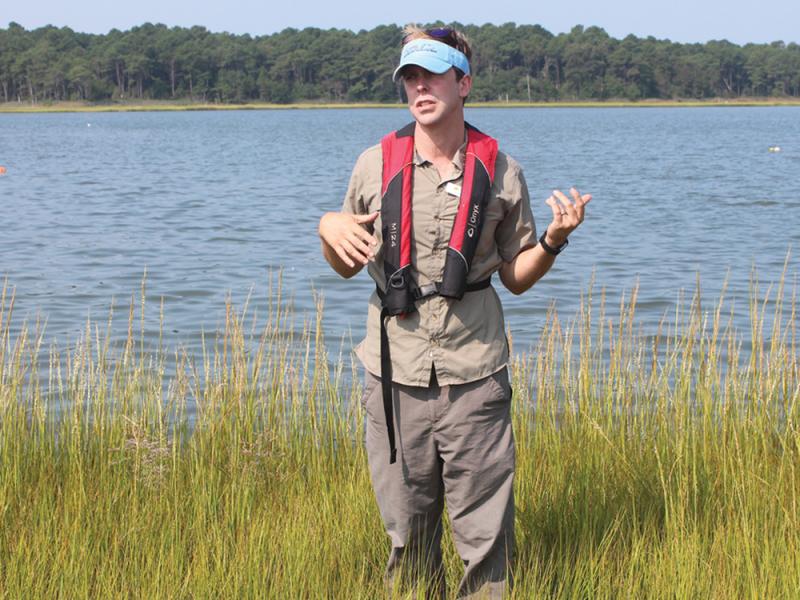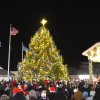I am with Chris Bason on the shore of Indian River Bay in ankle-deep warm water at a ribbon-thin band of beach that deserves to be called “delicate,” if that’s allowed.
“Delaware is my life,” said Chris. A child who loved the wild, he grew up in New Castle where he experienced firsthand an environment gone sour: bay water polluted with oil, the stink of benzene in the air. “Loss of natural spaces to development means lots of people rarely experience intact ecosystems – there’s little left for a kid to play in,” he said. So, to make sure this doesn’t continue, he became a professional ecologist.
Now in his mid-40s, he’s executive director of the Delaware Center for the Inland Bays, established in 1994 in keeping with Congress’ designation of the Delaware Bay as an “estuary of national significance.”
James Farm Ecological Preserve, a 150-acre tract near Bethany Beach owned by Sussex County and managed by the CIB, is the crown jewel. Chartered for public education and recreation, its trails meander the distinctive Delaware habitats leading to the water, from maritime forest through meadow, salt marsh and finally beach.
The bay here is punctuated by protruding peninsulas like fingers on a hand. They’re called necks, originally defined as a strip of land surrounded by water, and then broadened in America to mean a settlement in the forest, as in “neck of the woods.”
We’re on Cedar Neck, walking over old dunes that have become mixed woods. “Some trees here are over 200 years old – you can still see a few; they were left as property boundary markers,” said Bason. Today it’s mostly white and red oaks, and hickory trees. “Their nuts produce the mast – food of the forest.” They’re interspersed with holly groves. Trees were an important aspect of the region’s economy that provided material for everything from fuel to shelter to transportation.
I don’t notice until Chris points out how the elevation of the path descends at a gentle incline, making for a slight ridge that separates the woods from tidal in-flows.
“Super-sandy soil,” he observes. It was used for Delmarva’s first chicken house, built on a nearby neck when an order of 50 chicks showed up as 500 that had to be sheltered in winter. That started the broiler industry and furthered the transition of the area’s economy from one based on timber to one based on agriculture.
We reach the beach, what Chris calls tidal flats. “The ecosystem of the bay reveals itself here two times a day. It’s a really cool community of organisms. Mud snails crawl along the bottom eating algae; they burrow into the mud when the tide rolls out.” Turtles. Crabs. A hot spot for horseshoe crabs to mate in a mass inbound migration at growing season. The best fishing around, and 300 species of birds.
And clams. “This is a bastion for Delaware. They are healthy here because we don’t have the industrial land use you find elsewhere. You can eat them without worrying about getting cancer or frying your brain.” Two women are poking for some in the mud without success, so Chris directs them to his favorite spot several hundred yards farther up the bay. “I can get dinner there in 20 minutes anytime I want.”
What effects has he noticed from climate change? “The conversion of ecosystems from forest to marsh are happening so fast as the water level rises.”
We look backward to dead trees lining the upland edge of a meadow. “That comes from the marsh crawling all over. Forest trees resist but finally succumb to the salt water and other stressors.” He calls my attention to tall grasses spreading toward the woods. “Grass is the indicator of marsh that will become bay.”
The Center for the Inland Bays undertakes pollution-control projects as part of its mandate. These include reforesting a wetland with hardwoods and pines, and trying to restore forest on 80 acres of former farmland in the middle of the Great Cypress Swamp, which drains to the bay. Chris describes cypress swamps, which once abounded here, as “insanely full of life,” filled with eagles, owls, turkeys … even orchids.
Like others with whom I’ve beach walked, Chris fully appreciates the magnitude of the problems facing environmentalists. The foundations of life as we know it, the interdependence of fauna and flora, the habitats that sustain diversity, are all at risk.
“We’ve got a lot to teach; the challenges are only growing,” he said.























































